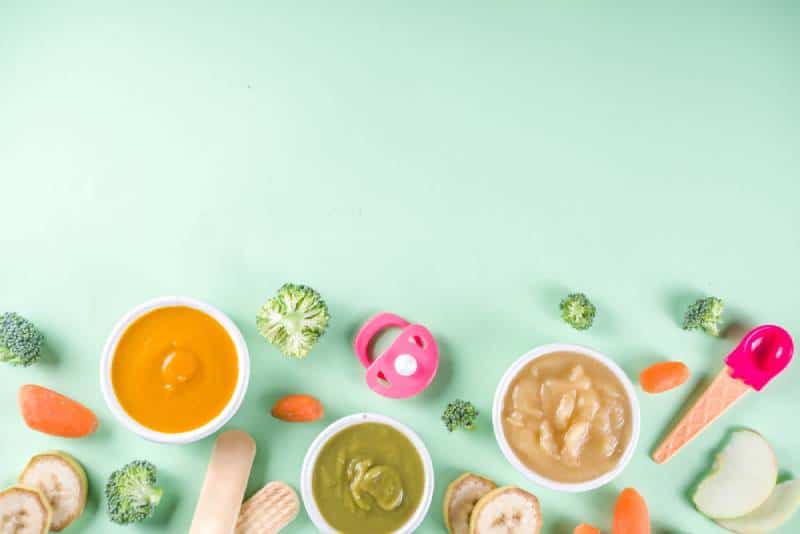Being a first time mother isn’t an easy job. In fact, it’s challenging, but every time you look at your little angel, you know it’s worth it.
You’ve done your research on everything from breast milk and baby food recipes, to potty training and discipline, and you think you are ready to deal with all that lies ahead. But, you can never be 100% ready because it’s all new to you.
Other moms have given you some advice on what worked for them, but every child is different, which means the same thing won’t necessarily work for you and your baby.
Pediatricians are always promoting breastfeeding. The first food of your babies should be your breast milk, but if that is not possible, then bottle-feeding and formulas will work too.
So, your little one is now a few months old and you want to start with solid foods.
Here’s some inside info about starting your little one on solids, and then we delve into yummy and easy-to-make homemade baby food recipes to make you a master at preparing your own baby food.
Let’s check it all out!
When Is The Right Time For Baby’s First Food?
This can be confusing for moms. There are many conflicting answers on the internet and not all pediatricians agree either.
Suffice it to say, there is no real right time!
Mind you, the general consensus to safely start giving your baby complementary foods is around the 6 month mark.
Don’t listen to others, though. No one knows your child better than you, mama! Trust your instincts and follow your baby’s lead on this.
“Complementary foods” are called that for a reason.
They are added to the diet when breast milk or formula alone are no longer enough to meet the nutritional needs of a baby.
Trust me on this; your little one will show you when they’re ready for solid foods.
Are they always watching you while you are eating? Do they have good head control? Can they take food from a spoon?
RELATED: Baby Self-Feeding Spoon: 12 Best Spoons For Your Little One
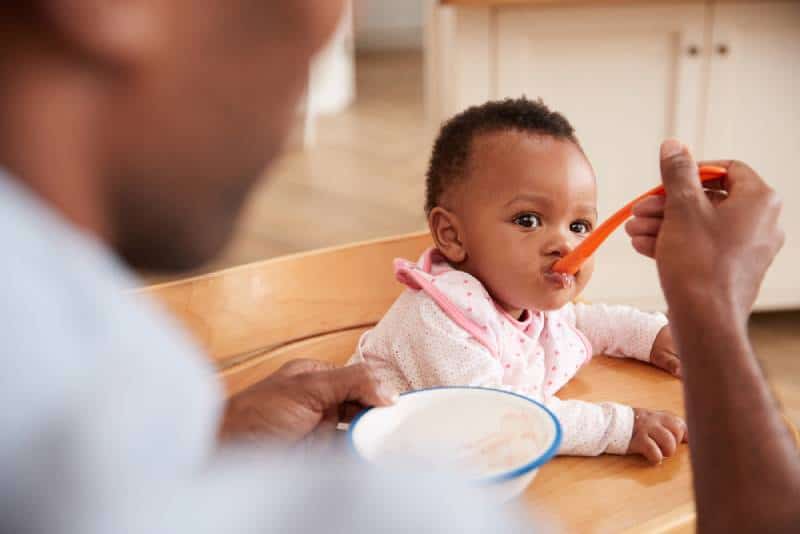
If your answer to these questions is yes, your baby is ready to try some baby purees.
But, be careful to introduce new foods bit by bit and in tiny portions – their tummies are going to be sensitive to anything other than breast milk or formula.
Equipment Needed To Make Your Own Baby Food
Making homemade baby food can be really easy if you have the right equipment.
- Food processor: Pick one where you can control the consistency and “chunkiness” of your baby food. Baby food makers are also easier than the average blender, where you can add ingredients, liquids, and seasonings as you steam and blend thanks to a chute that you can pass them through. Here are my recommendations for the best baby food steamer and blender:
| Image | Title | Price | Prime | Buy |
|---|---|---|---|---|
Top | Baby Brezza Small Baby Food Maker Set | PrimeEligible | Buy Now | |
 | QOOC 4-in-1 Mini Baby Food Maker | PrimeEligible | Buy Now | |
 | Duo Meal Station Food Maker | 6 in 1 Food Processor with Steam Cooker | PrimeEligible | Buy Now |
- Ice cube trays: This is a great mom hack for working mothers. Freeze your baby purees in ice cube trays, then store the puree cubes in a freezer bag to defrost one at a time as you need it. And presto – yummy meals for days to come!
- Cookers: It’s safe to say you all already have this. It’s important to thoroughly cook all meat and veggies before giving it to your baby.
- Bibs: Invest in bibs made of silicone or synthetic materials so they can be easily wiped clean. You’ll want to buy those that can protect skin and clothing. Get bibs that are easy to clean and are comfy for your baby to wear.
- High chair: Always consider your child’s safety when buying a high chair. You’ll want to make sure your seat features a restraint system like a 3- or 5-point harness, good stability, and nothing that’s going to pinch or catch on baby’s tiny fingers and toes.
How To Introduce New Foods
Use a plastic spoon with a soft tip and give your baby a little food on it. But don’t force anything.
They won’t open their mouth if they’re not ready, and that is okay.
This is their first time and it’s enough for them to just experience the smell and texture of solid food.
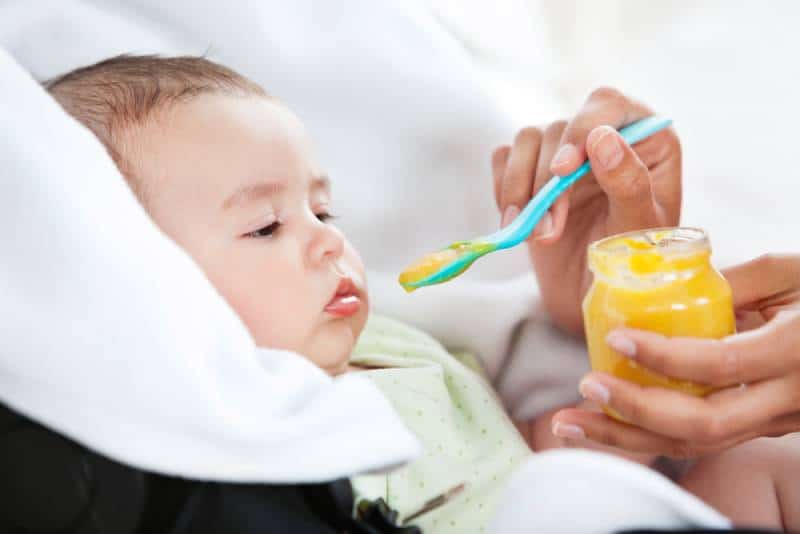
Remember, you’re not replacing milk or formula with solids at this stage.
In the first year, babies’ main source of nutrition should still be milk or formula.
Pay attention to foods that contain allergens. Common allergens include egg intolerance, peanuts, wheat, soy, fish, and shellfish.
When introducing solid foods, try to add only one ingredient at a time, and every other day introduce another, to be able to gauge which new food may be causing an allergic reaction.
And then, although it’s probably not necessary to mention, opt for organic ingredients wherever possible.
Just one last quick note: You can freeze baby food, but never when it contains milk or formula. If you want to add liquid to baby food you intend on freezing, use water instead.
Right, so let’s get started with baby food recipes already!
Homemade Baby Food Recipes With Veggies
1. Sweet potato puree
- 1 small sweet potato
- A splash of milk (breast milk or formula)
Peel the sweet potato and cut it into cubes. Add to a pot of boiling water and cook for 15 minutes.
Then, place it in a food processor, add milk, and puree it. Your fresh baby food is ready!

2. Broccoli puree
- 4 broccoli florets
- 1 small potato
- a drizzle of olive oil
Boil both veggies until soft. Mash or blend them up with olive oil, and voila, a new fresh meal for your tot.
Broccoli is full of vitamin C, which may positively impact your baby’s mood.
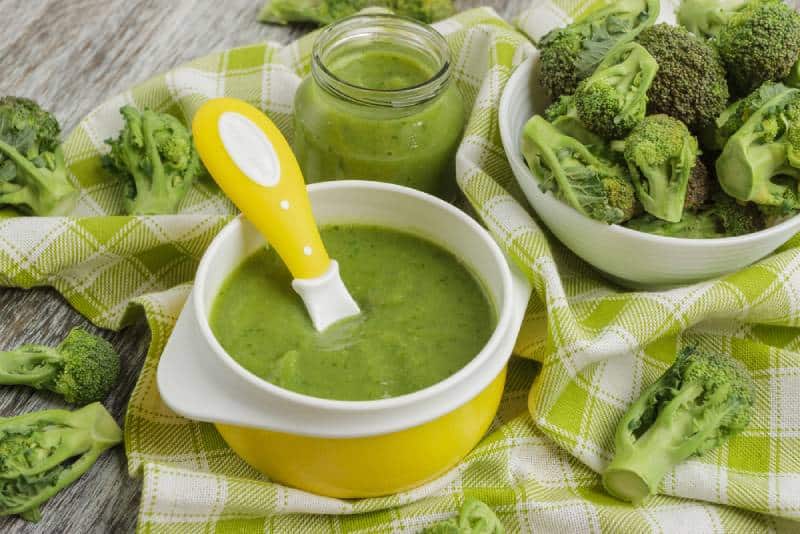
3. Veggie puree
- 1 carrot
- 1 small sweet potato
- 1 slice of butternut squash
Boil the carrot, butternut squash, and sweet potato for 20 minutes until all vegetables are soft. Mash it with a fork or mix in the blender until it reaches a smooth consistency.
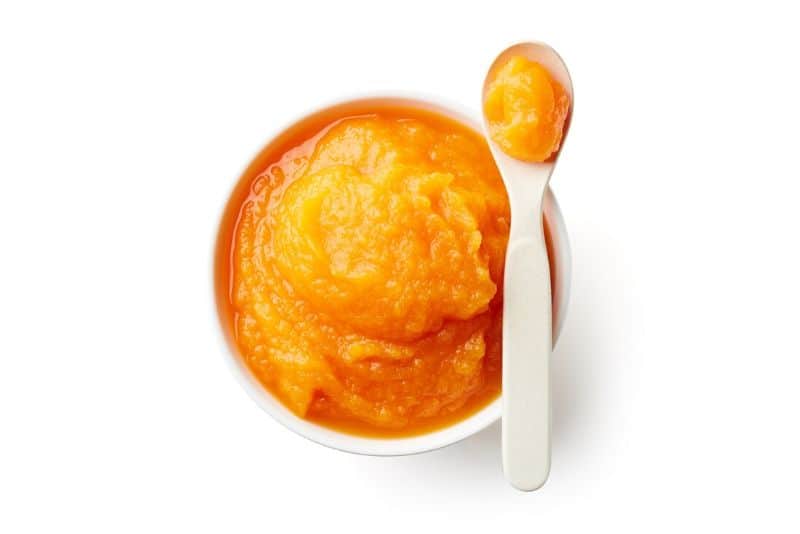
4. Quinoa baby cereal smoothie
- 1 cup of organic quinoa
- 2 medium apples
- ½ cup of blueberries
- 2 cups of milk or formula or water (if babies are 6+ months old)
Peel the apples and cook them in boiling water for 10 minutes, then add blueberries and leave for 5 more minutes.
Wash the quinoa thoroughly so that any remaining bitterness can be washed away. It needs a thorough pre-rinse in running water or a pre-soak in water.
Rub the seeds in both your hands during the rinsing process. Cook it for 15 minutes.
Then combine all ingredients with water and blend them. (Tip: For more flavor, you can use the boiling water you cooked the quinoa in.)
This smoothie is a great detox for your little ones.
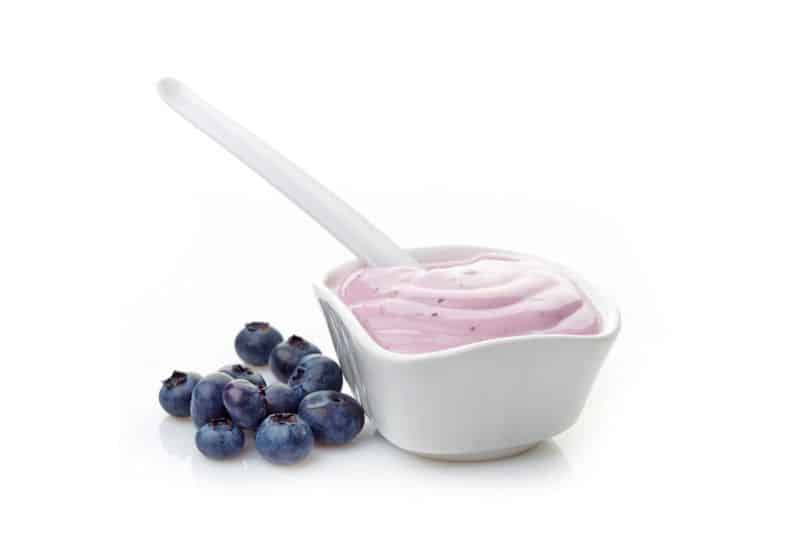
5. Beef and zucchini puree
- 2 carrots
- 1 zucchini
- 1 cup of ground beef
- 1 cup of water
Place ground beef into boiling water, then once it starts to brown, move it to a saucepan. Add the rest of the ingredients and cook over high heat.
After 3 minutes, reduce it to medium heat and cook for another 7 minutes. Puree it in a food processor. If the mixture is too solid, add more water.

Tip: Leave the skin on when preparing zucchini. The skin is where all those wonderful vitamins and nutrients are stored.
Zucchini contains vitamin A, which is great for bone growth and the immune system.
6. Avocado and banana puree
- ½ avocado
- 3 tsp breast milk / formula
- 1 banana
Wash, peel, and slice the banana.
Puree it with breast milk or formula for extra creaminess. Add avocado and blend it all together.

Optional extra: Add ½ cup of unsweetened applesauce. It’s good for baby’s digestion. In fact, you can add it in every puree you make.
7. Celery cream soup
- ½ cup celery, sliced thin
- 1 sweet potato
- 1 tsp olive oil
- 3 cup water
Roughly chop celery and sweet potato.
Put in a saucepan, add olive oil, and cook for 20 minutes. If needed, add more water. At the end, the liquid should just cover the veggies. Put it in a blender until silky smooth.
Now here’s is a healthy homemade soup for your baby!

8. Chicken, broccoli and carrot puree
- 50 g skinless, boneless chicken
- 5 broccoli florets
- 1 carrot
- ½ cup breast milk or formula
Chop the chicken into small pieces and cook for about 10 minutes in a saucepan with boiling water.
Cut the broccoli and carrot into small pieces (you can also grate the carrot), then boil the veggies for about 10 minutes or steam for 6-8 minutes.
Blend it all up and add milk or formula, blending until it becomes a smooth puree.
Tip: Always check that the chicken is cooked thoroughly, ensuring there are no pink spots left.

9. Turkey, rice and carrots
- 100 g turkey breast
- 4 Tbs rice cereal
- 1 carrot
- ½ peach
Cook turkey pieces in a pot with a scant amount of water – simmer until cooked (approx. 20 minutes).
Add the rice cereal to the cooked turkey and cook it for 3 minutes more. Add peach and leave it just for a minute or two more. Then process as needed for your baby’s texture preference.
Tip: You can substitute the peach for mango, papaya, or apricots, or combine them all together.

10. Veal and veggies
- 1 potato
- 100 g veal
- 1 carrot
- ½ parsnip
- ¼ cup chopped cauliflower
Put all ingredients in a steamer basket, then pour water to start the steaming process.
Once cooked, transfer it all to the food processor, reserving the cooking liquid.
Blend until smooth, adding a little bit of the cooking liquid (or breast milk / formula) at a time until you reach the consistency you like.

Homemade Baby Food Recipes With Fruits
1. Apple and banana puree
- 2 sweet apples
- 1 banana
Peel and cut the apples into small chunks. Chop the peeled banana into small pieces. Put them in a thick-bottomed pan and cover the fruit in water. Bring to a boil and simmer until soft.
Blend it up to required consistency. You can also add breast milk / formula if it’s too thick.

2. Mango and peach puree
- 1 mango
- 1 peach
- 1-2 cups water, breast milk or formula
- ½ cup baby rice cereal
Peel the fruit and cut it into chunks.
Blend up the mango, peach, and liquid, using just enough liquid to make the mixture blend easily. Mix cereal with boiled water and leave for a minute, then add it to your fruit mixture.
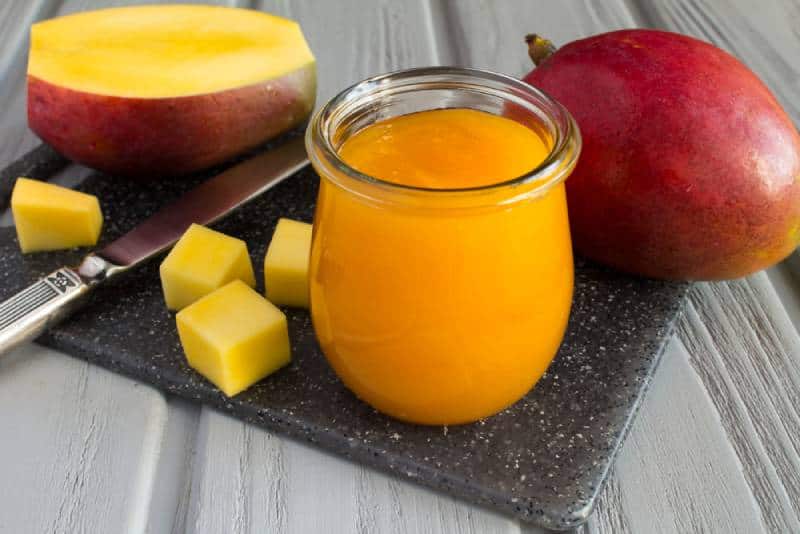
3. Nectarine smoothie
- 2 nectarines
Run nectarines under cold water. Place nectarines in boiling water and leave for 45 seconds, then remove. Place the fruits into an ice bath or cold water.
Once they are fully submerged in water, peel the skin. Pit and slice them into small pieces. Mix the pieces in a blender for a smooth consistency.
Add water to make a thinner smoothie consistency.
Tip: If your baby is 4-8 month old, nectarines should always be given peeled and boiled. And for the start, give them a small sample to ensure there is no allergic reaction.

4. Apple, kiwi and spinach puree
- 3 apples
- 1 cup baby spinach
- ½ kiwi
Place apples in a saucepan with just enough water to cover, then bring to a boil. Cook for about 10 minutes or until very soft.
Add spinach in the last 30 seconds of cooking time, then drain well.
Place apples and spinach, along with kiwi, into the processor. Mix until very smooth.
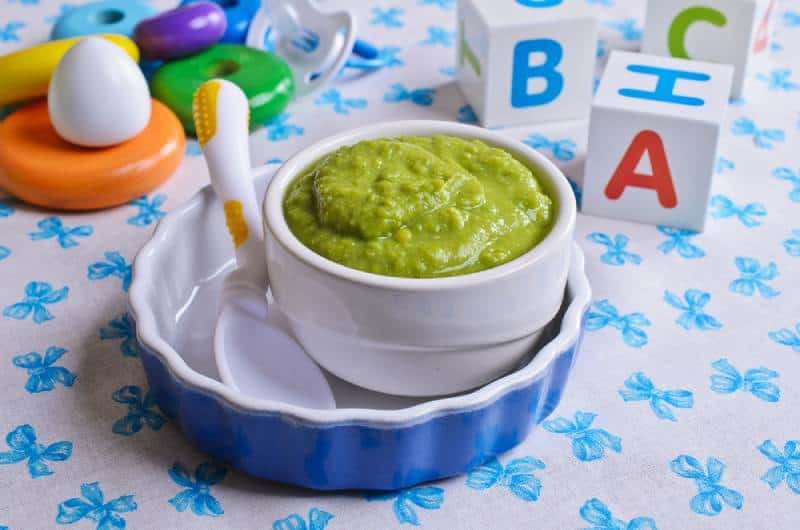
5. Warm apple, raspberry and dates
- 1 apple
- 200 g raspberries
- 10 dates
Peel and core the apple, then cut into pieces. Place the apple pieces, raspberries, and dates in a saucepan with a little water.
Cook for 5 minutes over low heat until they turn soft. Mix the ingredients and push through a sieve to remove raspberry seeds.
Serve it warm to your little one.
Tip: You can add dates to sweeten any of your baby’s foods.
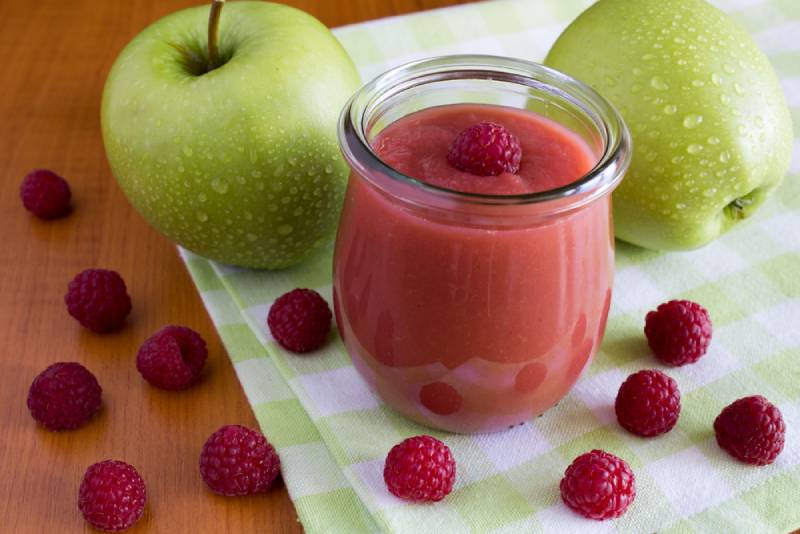
6. Tropical smoothie
- 1 banana
- ⅓ mango
- ⅓ papaya
Peel and cut the mango and banana into small pieces.
Peel papaya, remove the seeds and scoop out the fruit. Put all these in a blender and mix to required consistency.
Add water or milk for a smooth consistency.
Mmm, so yummy for baby’s tummy!

7. Summer berries puree
- 100 g strawberries
- 100 g raspberries
- 100 g blueberries
If the fruits are fresh, then wash and clean them, and remove any stalks. If frozen, defrost them following the instructions on the packet.
Combine all the berries and put them in a mixer or blender.
Blend until required consistency. Push it through a fine sieve to remove small seeds. Serve the freshly made berry puree to your baby.
Tip: Although not high on the list of allergenic foods, berries may trigger an allergic reaction, so give small samples to your baby the first time.

Final Words
The best thing about homemade baby food is that you don’t have to be a chef to make it.
And there are many advantages too: You know exactly what you’re giving your baby, it’s more economical, and your little one is getting used to eating the same food you eat.
When buying fruit and veggies for your baby, pay attention to two groups: the Dirty Dozen and Clean 15, which are lists of vegetables and fruits that have the most and least pesticides on them respectively.
And both lists change yearly based on current results and findings.
The most important ingredient in every baby food recipe is LOVE.
You are doing this because you only want the best for your tot. And to them, you’re the best chef in the world.
Keep going mama, you’re rocking baby’s first foods!
READ NEXT: The Importance Of Meat Baby Food – Best Recipes Included
Like this article? Please share or pin it for later. You can also stay in the loop and follow me on Facebook, Instagram or Pinterest.
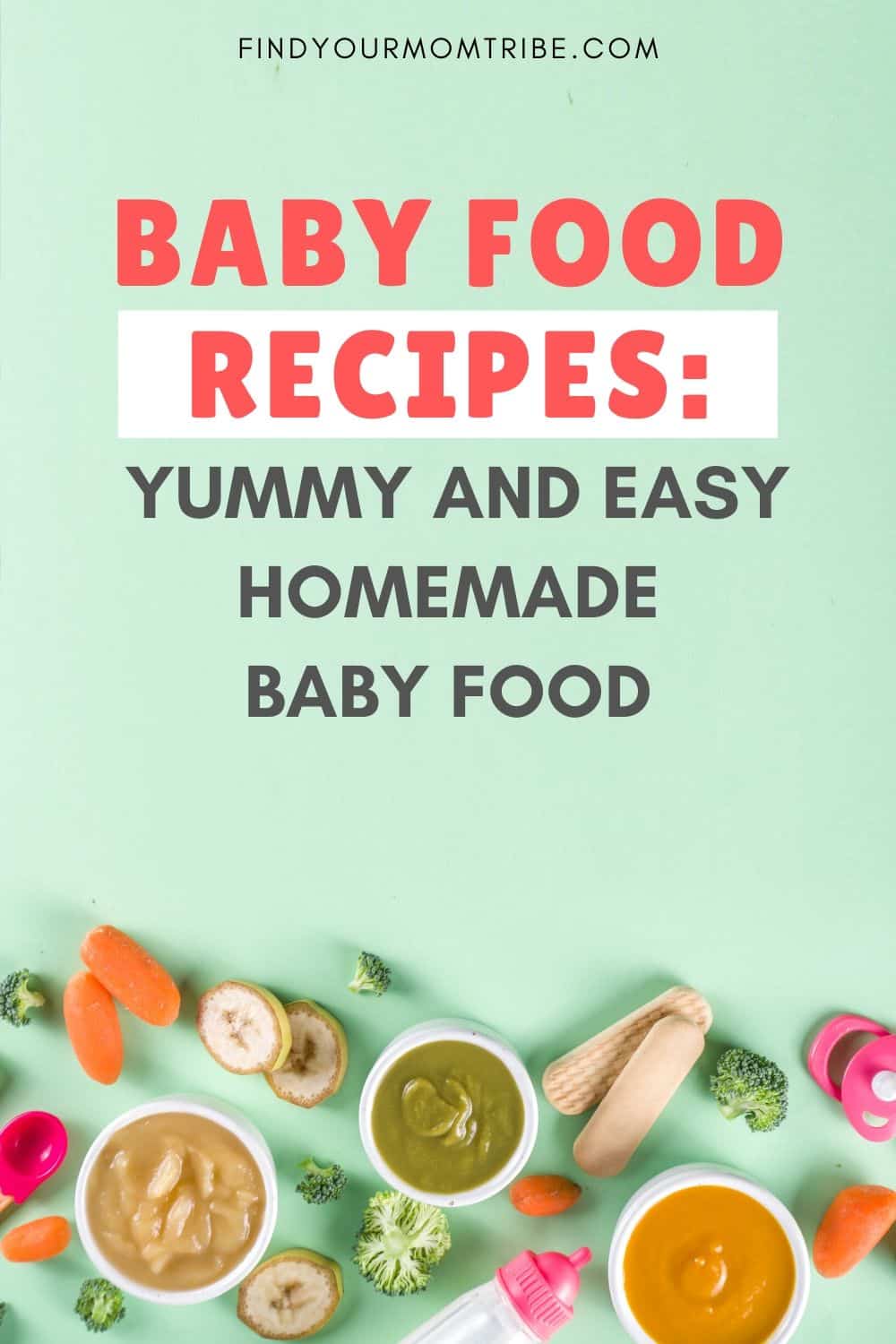
We love honesty! Find Your Mom Tribe is an Amazon Associate and we earn from qualifying purchases through affiliate links at no extra cost to you. Please see our full Amazon Affiliate disclosure for more information.

